Coordinación
Una coordinación sólida puede evitar vacíos y duplicaciones en las respuestas humanitarias, así como garantizar que los PTM complementen otros tipos de asistencia. Sin embargo, el informe del «Estado Global de los Programas de Transferencias Monetarias» de la CALP Network muestra que la coordinación de la asistencia en efectivo es vista como débil y ad hoc, y que esto está teniendo graves repercusiones operativas.
Los donantes, las ONG y los líderes de los grupos de trabajo de transferencias monetarias (GTM) han pedido claridad sobre tres temas principales relacionados con la coordinación de la asistencia en efectivo:
- Quién debe ser responsable de asegurar una coordinación eficaz de la asistencia en efectivo;
- Cuál es la función y el mandato de los grupos de trabajo de transferencias monetarias, incluso en relación con las transferencias monetarias multipropósito;
- Cómo se debe dotar de recursos a la coordinación de asistencia en efectivo.
Tenemos que basarnos urgentemente en lo que funciona y proporcionar claridad a nivel mundial sobre las preguntas arriba mencionadas, adaptándonos a los diferentes contextos. Hace mucho tiempo que se deberían haber tomado decisiones claras basadas en necesidades operativas y no en la política de las agencias.
Prioridades actuales
El objetivo de la CALP Network es contribuir a seguir progresando en este tema en tres niveles: apoyar a los grupos de trabajo de transferencias monetarias a nivel regional; contribuir a soluciones prácticas para la coordinación de la asistencia en efectivo a nivel mundial; y convocar una discusión basada en la evidencia sobre temas clave, destacando puntos de decisión críticos y oportunidades de progreso.
Contenido destacado
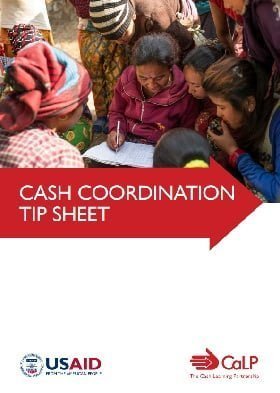
Cash Coordination Tip Sheet
Guidelines and Tools
This tip sheet sets out established best practice, key guidance and resources for all aspects of cash coordination, intended as a clear, accessible and action-oriented guide for those engaged in coordination of cash and voucher assistance (CVA) at the field level.
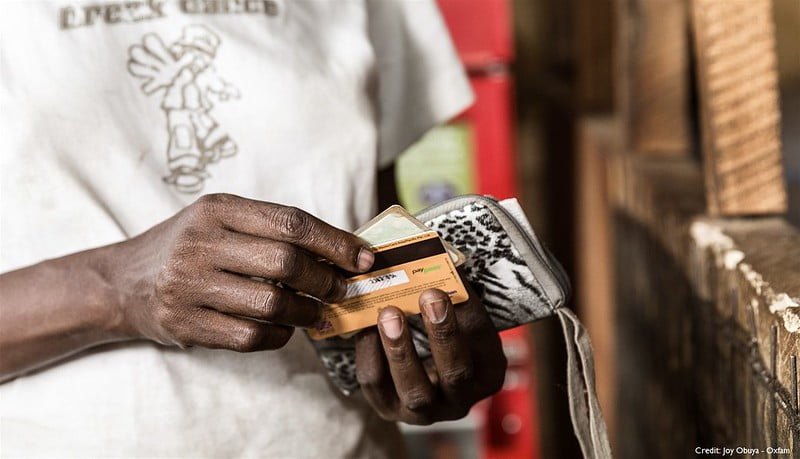
Introducing the Cash Coordination Tip Sheet
Webinar
The CALP Network has developed a tipsheet setting out established best practice and key guidance and resources for all aspects of cash coordination, intended as a clear, accessible and action-oriented guide for those engaged in coordination of cash and voucher assistance at the field level.

Cash Coordination: A proposal from members in MENA
Blog Post
Earlier this year the CALP Network undertook regional consultations to explore options for cash coordination. This blog lays out recommendations from participants from the Middle East and North Africa who sketched out what cash coordination, and coordination more broadly, could look like in future to support a more effective, efficient and accountable response.
Últimos recursos

Linking CVA and Social Protection in the MENA Region – Lebanon Case Study
Report
Building linkages between humanitarian cash and voucher assistance (CVA) and social protection (SP) has become an increasingly prominent topic over the past five years and the Middle East and North Africa (MENA) region has been at the centre of this evolution. The objective of this resource set (the...

Responding to the COVID-19 Crisis: Linking humanitarian Cash and Social Protection in practise
Report
This paper seeks to demonstrate practical ways in which NGOs are linking their humanitarian work to social protection and the added importance of this in the context of COVID-19, following from the earlier work of CCD outlining the role of NGOs to
improve the access to and delivery of social protection in...

Webinar: Lecciones aprendidas en la provisión de transferencias monetarias en Colombia y Ecuador en respuesta a la crisis de Venezuela
Webinar
Nos complace invitarle a asistir al webinar para el lanzamiento del resumen ejecutivo del informe de hallazgos sobre el análisis de las lecciones aprendidas en la provisión de transferencias monetarias en Colombia y Ecuador en respuesta a la crisis de Venezuela. Este evento es organizado conjuntamente...

The State of the World’s Cash 2020: Global Launch Webinar
Webinar recording
The slides and recording from the launch webinar are now available to view and download.

Kenya Cash Working Group Achievements | JULY 2020
Report
The Kenya Cash Working Group’s (KCWG) operational information map (4 Ws) shows the various CVA actors’ coverage as of June 2020. Those actors are responding to different emergencies in Kenya including Rapid-Onset flooding, Desert locust invasion and COVID-19 pandemic funded by various donors.

Cash and Voucher Assistance and Risk: Perception vs Reality Grand Bargain Cash Workstream Annual Virtual Meeting
Webinar
You are invited to a webinar hosted by the CALP Network and WFP under the Grand Bargain cash workstream annual virtual meeting umbrella. Is cash assistance riskier than in-kind? All the evidence says no, but we still act as if it is. Join us for this important conversation diving into the world of CVA and...
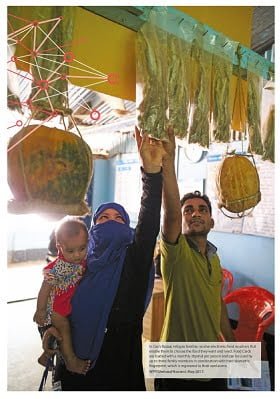
State of the World’s Cash 2020 – Chapter 6B: Investing in innovation for CVA
Report
Since 2017, the appetite for CVA innovation has decreased slightly as has the percentage of practitioners (46%) who agree that humanitarian agencies and private sector actors are developing effective working relationships in CVA programmes. Despite this, digital finance and the use of mobile money has...
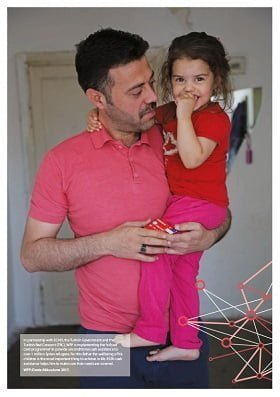
State of the World’s Cash 2020 – Chapter 4: Build sufficient capacity for cash and voucher assistance
Report
Since 2018 individual and organisational CVA capacities have improved, and are having a positive impact on the timeliness and scale of CVA. But dedicated funding for CVA capacity building is generally insufficient and unpredictable and recruiting and retaining skilled staff remains a challenge. This...
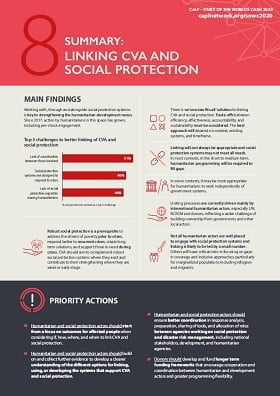
State of the World’s Cash 2020 Chapter 8 summary: Linking CVA and social protection
Report
Longstanding efforts to strengthen links between humanitarian CVA and social protection have been accelerated by the COVID-19 pandemic, with significant progress since the last report. CVA should aim to complement robust social protection systems where they exist and contribute to their strengthening...
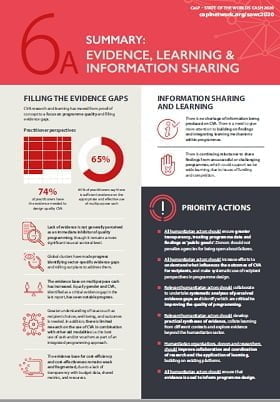
State of the World’s Cash 2020 – Chapter 6A summary: Evidence, learning & information sharing
Report
Three-quarters of practitioners agree that they have the evidence needed to design quality CVA. However some critical evidence gaps remain for example around recipient choice and wellbeing, cost effectiveness and the use of CVA in combination with other aid modalities. This chapter asks: ‘How can...
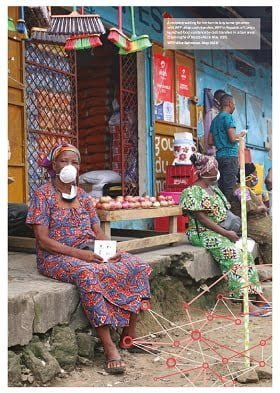
State of the World’s Cash 2020 – Chapter 9: COVID-19 and CVA – Impacts and Implications of the Crisis and Response
Report
CVA is being scaled up significantly in response to COVID-19, but the overall gap between needs and funding is growing rapidly. The pandemic has incurred an extraordinary human cost, but also presents an opportunity to redefine the humanitarian system to better serve the needs of crisis-affected people....
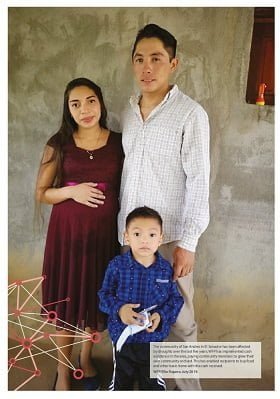
State of the World’s Cash 2020 – Chapter 8: Linkages between SP and CVA
Report
Longstanding efforts to strengthen links between humanitarian CVA and social protection have been accelerated by the COVID-19 pandemic, with significant progress since the last report. CVA should aim to complement robust social protection systems where they exist and contribute to their strengthening...

State of the World’s Cash 2020 Chapter 1 Summary: Funding, Policies, Volume and Collaboration
Report
In the past four years, the global volume of CVA has doubled and in 2019 accounted for 17.9% of international humanitarian assistance. Tracking of CVA volume data is improving and 91% of practitioners perceive that support from donors has increased. This chapter asks: ‘As the global volume of CVA...

Cash and Voucher Assistance and Risk: Perception vs Reality Grand Bargain Cash Workstream Annual Virtual Meeting
Webinar recording
Webinar hosted by the CALP Network and WFP under the Grand Bargain cash workstream annual virtual meeting umbrella.
Is cash assistance riskier than in-kind? All the evidence says no, but we still act as if it is.
During the Covid-19 pandemic CVA has been the modality of choice in humanitarian responses....
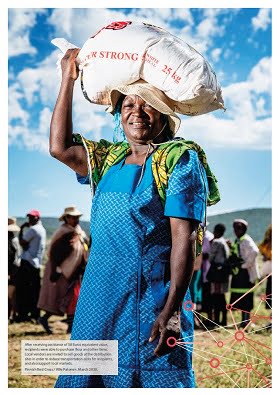
State of the World’s Cash 2020 – Chapter 2: Mainstreaming CVA – Progress; Risks and Challenges
Report
CVA is an increasingly common and well-understood tool in humanitarian response – 85% of practitioners perceive that there has been more systematic consideration of CVA over the last 2 years.This chapter asks: ‘How can ambitions for scaling up CVA be met whilst also pushing for better, more...
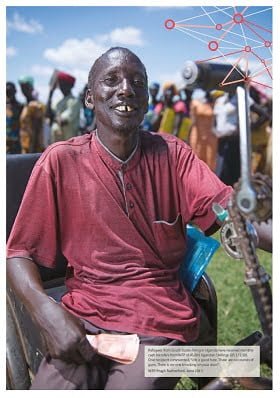
State of the World’s Cash 2020 – Chapter 3: Quality Programming
Report
67% of practitioners report that the quality of CVA has increased in the last two years. The focus for improving CVA has gradually shifted from increased scale, to improved quality and more recently towards quality as defined by outcomes for recipients. This chapter asks: ‘How can we continue to...
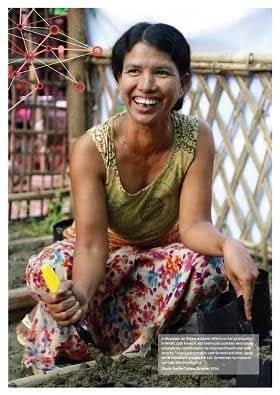
State of the World’s Cash 2020 – Chapter 1: Funding, policies, volume, and collaboration
Report
In the past four years the global volume of CVA has doubled and in 2019 accounted for 17.9% of international humanitarian assistance. Tracking of CVA volume data is improving and 91% of practitioners perceive that support from donors has increased. This chapter asks: ‘As the global volume of CVA...
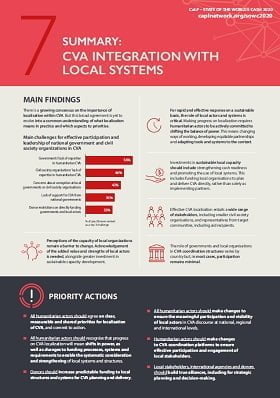
State of the World’s Cash 2020 Chapter 7 summary: CVA integration with local systems
Report
For a relevant and sustainable response , the role of local actors and local systems is critical. There is a growing consensus regarding the importance of localisation within CVA, but little clarity on how to drive this forward in practice. Progress on localisation requires humanitarian actors to be...

The State of the World’s Cash 2020 Report: Global Launch
Webinar
This 90-minute webinar and Q&A will launch The State of the World’s Cash 2020 Report, present a complete picture of the state of CVA in 2020, and explore how we can all work together to better meet the needs of crisis affected people. The State of the World’s Cash 2020 draws on inputs from hundreds of...

State of the World’s Cash 2020 – Chapter 6A: Evidence, Learning & Information Sharing
Report
Three-quarters of practitioners agree that they have the evidence needed to design quality CVA. However some critical evidence gaps remain for example around recipient choice and wellbeing, cost effectiveness and the use of CVA in combination with other aid modalities. This chapter asks: ‘How can...